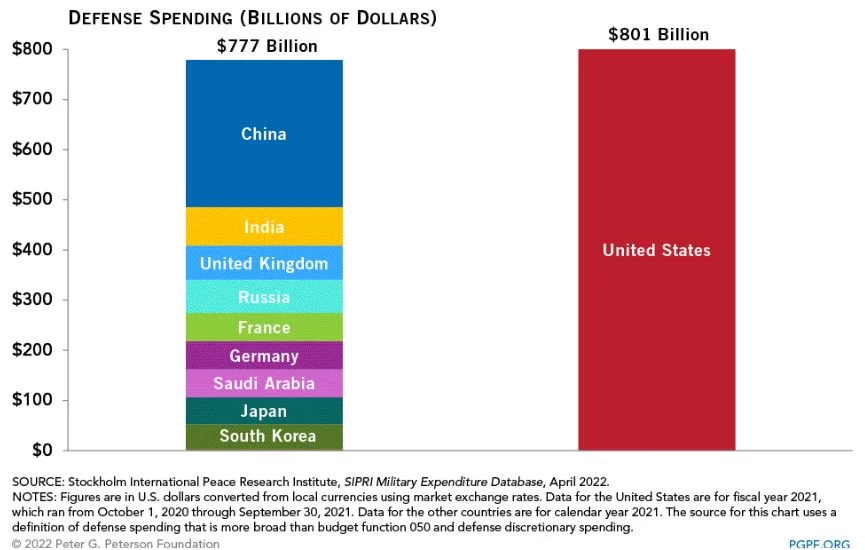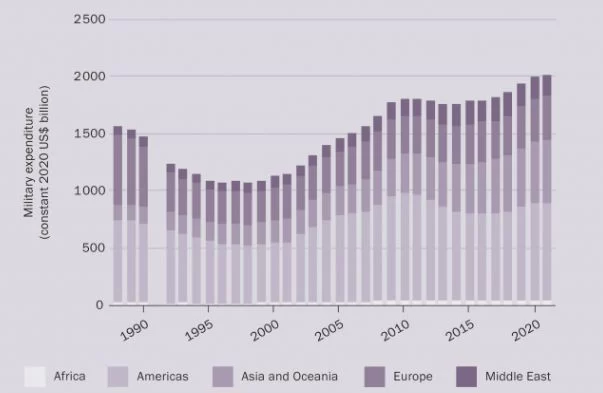Military or hard power was considered the primary source of power for states for many years. However, in the post-Cold War period, economic or soft power took precedence over hard power. In addition to the “end of history” thesis, the dramatic decrease in interstate warfare contributed to the popular belief that war would soon become a memory of the past and countries would be less reluctant to spend in the development of their military strength. But, things are not looking as they were expected. The world has been experiencing massive-scale militarization and a rising defense budget for the last few years which is well captured by the Global Firepower 2023 Military Strength Ranking. The Global Firepower Index (GFP) is an annual ranking of countries based on their military strength. It takes into account a variety of factors in determining the military strength of countries which helps us to get a global overview of how countries are beefing up their military strength. Given the global geostrategic shift, intensifying rivalry among powerful nations, and external security environment, countries are more likely to strengthen the military further which will not bring any good to world peace and security.
Overview of the Global Firepower Index
Since 2005, the Global Firepower Index (GFP) has been providing an annual ranking of countries based on their military strength utilizing over 60 different factors. These factors are grouped into eight categories which are — geography, manpower, airpower, naval power, land power, financials, resources, and geography. GFP began with only 25 countries and has since expanded to 145 nations. Every year, new factors are included to capture the changing dynamics of power, as this year, an expanded focus was given to natural resources and shared borders. Lastly, a perfect score is 0.0000 which is realistically unattainable. In this sense, the smaller the PowerIndex (PwrIndx) value, the more powerful a country’s conventional fighting capability is.
A Global Comparison of Military Strength in 2023
In GFP 2023, the United States is ranked as the top military power in the world with a score of 0.0712 which was 0.0718 in the previous year. The second and third most powerful militaries are Russia and China with a score of 0.0714 and 0.0722 which were 0.0791 and 0.084 last year respectively. It really shows the growing military strength and closing gaps among the top three powerful countries as the US and Russia are separated by only 0.0002 points from each other and China is separated from the US by only 0.0010 points which was much wider last year.
If we compare the military strength between the US and Russia categorically, the US has the upper hand in airpower, financials, logistics, and geography, whereas Russia has the upper hand in manpower, land power, naval power, and natural resources against each other. The US has ten aircraft carriers and a technological edge over Russia with a staggering military budget of around $782 billion in 2022. On the other hand, Russia possesses huge land power as it has 12950 tanks, 6083 units of self-propelled artillery, and 3860 rocket projectors on land with the largest stockpile of nuclear warheads. China has the world’s largest navy and the highest number of active military personnel which is around 2,000,000.
Besides the top three, India has been maintaining its 4th position since 2006. It has the second-highest active military manpower after China which is 1,450,000. With access to nuclear power, India has 4740 battle tanks, 841 aircraft, and a growing economy of $3.5 trillion. One important thing to notice here is the growing gap between the top 3 and the rest of the countries in the index, as India has a score of 0.1025 compared to the Chinese score of 0.0722.
Among the top 10 countries, the United Kingdom (UK) and Pakistan have improved their positions, as the UK is ranked 5th and Pakistan is ranked 7th in the index compared to their previous 8th and 9th positions respectively. On the other hand, Japan and France were demoted to 8th and 9th positions from their previous 5th and 7th positions. One very interesting fact here is that despite a small amount of the Pakistani military budget which is ranked 29th among 145 countries, Pakistan has been able to beat other countries like Germany and France which have much bigger defense budgets. Moreover, Pakistan is ranked the top military power in the Middle East and North Africa (MENA) region which is followed by Turkey, Egypt, and Iran.
Along with these, a lot of changes have taken place in the middle ground of the index. Ukraine, which was placed 22nd last year, is now ranked 15th in 2023 as a result of the financial and military support from the West in a response to the Russian invasion. Similarly, Turkey, Taiwan, Poland, and Vietnam saw a massive leap this year in their rankings, given their growing political significance in world politics. On the opposite, Germany, Iran, and Saudi Arabia have been demoted from their previous positions. Another important feature is “power on the rise”. This year, GFP identified 53 countries that are improving in their military strength and have the potential to become future military powers. This really shows the growing militarization worldwide, even the developing nations are not lagging behind.
If we see the region-wise military strength, most military powers are concentrated in the Asia-Pacific and Asian regions. According to the GFP Regions data, a total of 26 countries are included in the Asia-Pacific and most of them are ranked among the 25 top most powerful countries in terms of military strength in the world. It indicates the growing political significance of the Asia-Pacific region. The Asian region, which includes the highest number of countries, is the second most powerful region as it includes Russia, China, and India which are also parts of the Asia-Pacific region. Most interestingly, GFP identifies seventeen countries from the Asian region as the “power on the rise”. These signal the world’s geostrategic shift to Asia and Asia-Pacific from the Euro-Atlantic, as countries are more inclined to develop their military power to strengthen their positions there. European Union, another region in the GFP, has shown great interest in military development as countries are striving to reduce their dependency on the West and achieve self-sufficiency in ensuring their security, especially after the Ukraine war. Besides these, the other two regions the Middle East and the Persian Gulf have shown a relative decrease in military strength from previous years as countries are marred with political and economic crises.
In terms of worldwide military expenditure, global military spending reached $2.113 trillion and observed growth for seven consecutive years in 2021. According to GFP 2023, the US remains the highest military spender with an amount of $762 billion, along with China, Russia, India, and Germany. Interestingly, the US single-handedly spends more than the rest of the countries in the top 10 highest military spenders of the world. Besides these top ten countries, the rest of the world spends only 25% of the world’s total military expenditure.

Figure 1: Defense spending of the US and other countries
Moreover, stark differences are also there in terms of region-wise military spending. Americas, along with ‘Asia and Oceania’ are the two regions with the most military expenditure. These two regions are followed by Europe, the Middle East, and Africa. One important trend here to notice is that the average defense expenditure of ‘Asia and Oceania’ and Europe is increasing faster than Americas over the past few years.

Figure 2: Military expenditure by region.
The Reasons Behind the Increasing Focus on Military Power
Military power is back and there are many reasons behind that. One main reason is the growing number of interstate wars which have been dormant since the end of the Cold War. In just one month after the outbreak of the Russia-Ukraine war, seven European nations like Germany, Italy, and Poland increased their defense budget. The global strategic shift is another reason that has contributed to the increasing focus on military power as countries are trying to strengthen their grip on particular regions through their military might. Such as the US has a strong military presence in the Indian Ocean, whereas China has military bases in the South China Sea.
Growing rivalry and polarization among powerful countries have also led to growing competition in the military domain. Such as, China has increased its defense budget from a nascent $14.6 billion to $229 billion in the last twenty years. Similarly, the US announced a defense budget of $816 billion for FY23. Furthermore, joint military exercises among like-minded states and the formation of alliances like the AUKUS and QUAD have intensified the competition.
In addition, pressure from powerful countries like the US on its allies to increase their defense budget is also noticeable. For example, Japan has implemented a 20% increase in its defense budget in 2023 from the previous year. Likewise, NATO has made it obligatory for its member states to spend more than 2% of GDP on the defense sector.
The external security environment and existing security dilemma have prompted countries to shift focus on military power and secure their strategic autonomy by reducing their dependency on external powers for security. The development of new sophisticated military technologies and force modernization have also compelled countries to invest more in defense. Moreover, worldwide economic growth over the last century has definitely helped countries in this regard. Nonetheless, favorable public opinion on military power has also paved the way to spend more on defense.
The Global Firepower Index provides a good overview of worldwide military strength, as it rightfully captures the growing militarization coming into 2023. A growing focus on military power means less focus on diplomacy, lack of mutual trust, defiance of existing international instruments, less funding for non-military threats like poverty and environmental protection, and fear of an intensified arms race that will be catastrophic for the world. In this context, countries should always focus on limiting the use of military power and rely more on dialogue to resolve their disputes peacefully.
[U.S. Navy photo, via Wikimedia Commons]
The views and opinions expressed in this article are those.

Muhammad Estiak Hussian is a Research Analyst at the KRF Center for Bangladesh and Global Affairs (CBGA).

